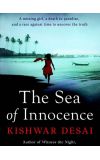
30 Jun 2013 00:34:55
Simran Singh, the recurring narrator-heroine of Kishwar Desai's mystery novels, is an unusual mixture – not exactly a rebel but very far from conforming to Indian social codes. She drinks both beer and whisky, and on her holiday in Goa (where this rather sombre adventure is set) sees the dilatoriness of the Indian government as a blessing for once, since a long-proposed ban on beach smoking hasn't yet come into force. She describes herself as a strong atheist but can be moved to light a candle in church for a missing girl.
Though Simran is in her 40s, so that it's hardly surprising her mother (an offstage character here) should be keen for her to settle down, she's in no particular hurry to stop playing the field. Even so, she's not by any but the strictest standards a loose woman. It's hardly a question of her fearing commitment, since she has adopted a girl called Durga – now 16 – from a traumatic background. Getting a henna tattoo on the beach, Durga teases her that she should get one too, a dragon tattoo. The reference to Stieg Larsson's Lisbeth Salander mocks Simran's "penchant for trying to solve difficult crime cases", though she's a social worker by profession.
In practice, by this stage (The Sea of Innocence is the third in the series) the character's professional background has become a technicality. There are no details given of her work life and when she uses the words "case" and "investigation" they have only the standard detective overtones.
No holiday destination is as untroubled as the brochures make out, and Desai gets a little overheated (and a little incoherent) about the shadow side of Goa: "There was a looming darkness around the edges. Like a hungry nocturnal sea animal, it padded through the sand, seeking victims…" One likely victim is Liza Kay, a British teenager who seems to have vanished, though she turns up in sexually charged video footage sent to the authorities. Someone is trying to make trouble, and important people are beginning to wonder if they can take their immunity for granted.
Unlike her heroine, Desai can't seem to forget her day job (she's a columnist). She keeps relapsing into opinion-mongering in a way that works against the possibility of thriller tension. "Was it a larger problem that an apparently modernising India did not know how to deal with female sexuality, and assumed that normal, friendly behaviour and western clothes meant that the women were available?"
Desai has spent plenty of time in Goa (it's given as one of her places of residence in the biographical note) but rarely rises above a bland Lonely Planet note: "On the surface the state seemed so peaceful. But from all accounts it too was torn between the ghosts of its Hindu, Muslim and Catholic history and the dreams of the future…"
Journalism can enrich a thriller but it needs to be harder-edged than this, less slackly editorialising. The nearest approach to reportage is a description of a visit to an electronics store in Anjuna village, where an old woman matter-of-factly recounts the brutal treatment of her nephew, not only by criminals but the police. These pages come alive. Urgency fades with the return of the think-piece tone: "…in many ways vulnerable, poor and thus marginalised men in this country were as much at the mercy of the police as women were."
Desai's grasp of non-Indian lives is sometimes weak. Is Liza's 24-year-old sister supposed to be telling transparent lies when she says: "I'm just about to go to Oxford University – managed to get in…"? Apparently not. This academic coup is one of the few things she's not lying about.
The thriller isn't a high-minded form and resists being recruited for a social agenda. If, like Stieg Larsson, you go to extremes in your depiction of violence against women, you may achieve not sensitisation to the issues but simple numbness. In the case of The Sea of Innocence, the gap between the form and the imagined intention is impossibly wide. The cover copy teases with: a missing girl, a death in paradise and a race against time to uncover the truth. The book's dedication reads: "For Jyoti, Scarlett and the thousands of women who have been raped and murdered in India – in the hope that one day they will get justice."
Jyoti was the name of the girl raped on a bus in Delhi. No doubt this case dominated the headlines while Desai was writing but it doesn't earn its place in the book. Scarlett Keeling's name is a problem for the opposite reason, being all too close to the story, since this was the British teenager raped and murdered in Goa a few years ago (her death classified as accidental until her mother found evidence).
Of course real-life crimes can suggest thriller plots – the kidnapping of the Lindbergh baby is there in the background of Murder on the Orient Express. But the references to Scarlett Keeling and her mother, Fiona MacKeown, are constant. Desai even quotes from an email of Keeling's (took sum md an lsd and xstasy I was soooo fuked man), certainly more vivid than the commentary: "It was the story of a young girl leading an artificial and very adult life, where she was seemingly pushed frenetically into one disturbing situation after another."
Despite the pious dedication, it's hardly respectful to exploit the sufferings of a real teenager to give your thriller more impact. Family tragedy in the headlines isn't something to be crumbled over a concocted story, like a stock cube, in an effort to boost the flavour.

